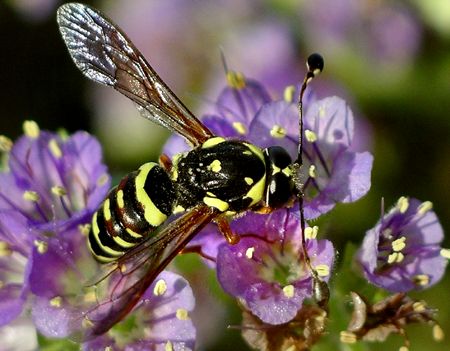by Valerie
February, 2019Pollen Wasp
One of the weirder insects in our area is the pollen wasp (Pseudomasaris texanus). Both sexes have distinctive antennae, but those of the male, as shown here, are especially long and heavily clubbed. But their appearance isn't the strangest thing about them. The vast majority of wasps, including all other members of the family vespidae (which includes paper and mason wasps as well as yellowjackets) have carnivorous larvae. The adults must provide insect or spider meals for their progeny. Pollen wasps, as their name suggests, instead pack a nest with pollen as food for their larvae. Being a wasp, the female (who does all the nest provisioning) does not possess the specialized hairs or structures of bees that allow them to carry pollen. Instead, she utilizes an adaptation found also in a few hairless bees: she swallows the pollen, stores it in a throat pouch called a crop, and regurgitates it back at the nest. This species has a very restricted diet and only feeds at Blue-curls (Phacelia congesta), a spring-blooming annual. One curious fact is that bees have vegetarian larvae just like this wasp does, but they evolved from a different family of carnivorous wasps: crabronidae. The dietary switch in both bees and pollen wasps is speculated to have occurred when ancestral wasp larvae gradually adapted to feed on pollen coating their prey. |